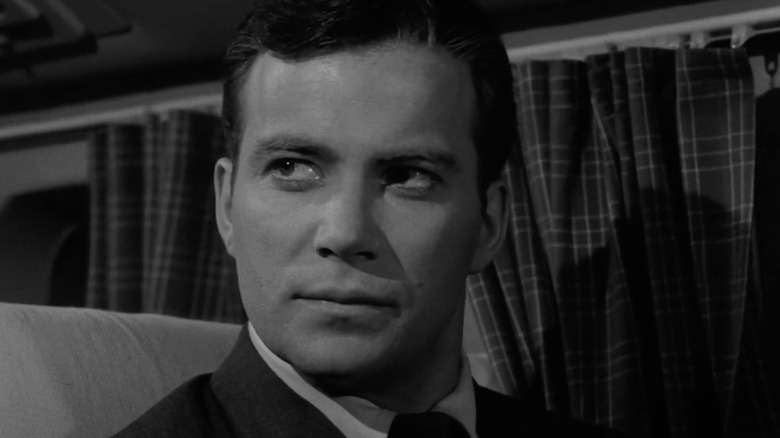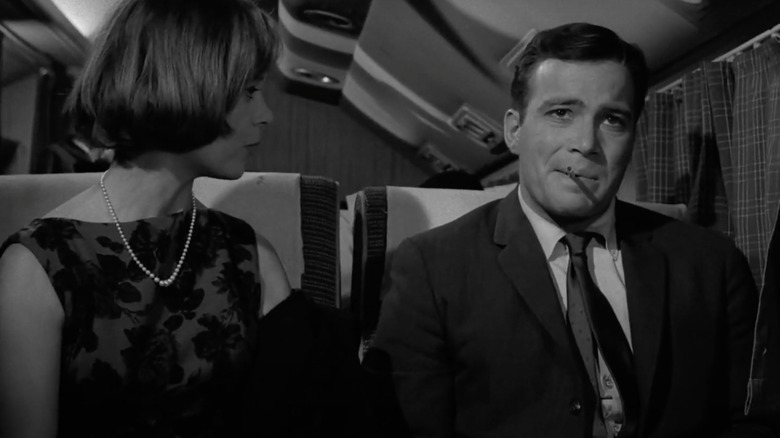The Original Vision For The Twilight Zone's Nightmare At 20,000 Feet Was A Little More Lighthearted
Among his many other literary and cinematic distinctions, Richard Matheson wrote 16 episodes of "The Twilight Zone." Without a doubt, Matheson's most famous contribution to the series was the episode "Nightmare at 20,000 Feet," starring future "Star Trek" captain (and space-faring /Film contributor) William Shatner.
Directed by Richard Donner ("Superman," "Lethal Weapon"), "Nightmare at 20,000 Feet" is described in host Rod Serling's narration as the "portrait of a frightened man, Mr. Robert Wilson," who has "just been discharged from a sanitarium where he spent the last six months recovering from a nervous breakdown." At the beginning of the episode, Wilson boards a plane with his wife Julia (Christine White), which spells immediate trouble since his breakdown occurred on a previous flight.
"Tonight," Serling continues, "he's traveling all the way to his appointed destination, which, contrary to Mr. Wilson's plan, happens to be in the darkest corner of the Twilight Zone." That dark corner, with its big, furry gremlin only Wilson can see (a plight not unlike that of the cartoon construction worker driven destitute and mad by the singing and dancing Looney Tune, Michigan J. Frog), originally had a more lighthearted inspiration.
Matheson himself revealed this in an on-camera interview with the Television Academy Foundation. When asked where the idea for "Nightmare at 20,000 Feet" came from, he said:
"I was on an airplane, and I looked out, and it was all these fluffy clouds. And I thought, gee, what if I saw a guy skiing across that like it was snow? Because it looked like snow. And then, when I thought it over, that was not very scary, so I turned it into a gremlin out on the wing of the airplane. And it was published as a novel at first, and then I sold it to 'Twilight Zone.'"
Brain of an idea man
Matheson's anecdote explaining how the "Nightmare at 20,000 Feet" idea originated just goes to show how the brain of a good writer works. He was capable of plucking ideas from his surroundings and the seemingly innocuous mental picture of a skier in the clouds.
The rain gremlin in "Nightmare at 20,000 Feet" arises as the physical manifestation of Wilson's self-described "over-tension and over-anxiety." The fear of flying is a common one, and the idea of a danger you alone can see is also timeless and elemental in its potency.
In his stories, Matheson was the quintessential idea man. Lest we forget, he also penned "Duel," the 1971 TV movie that gave Steven Spielberg his directorial start. As a novelist, Matheson is best known for the highly influential "I Am Legend," which has been adapted into three different films: "The Last Man on Earth," "The Omega Man," and the eponymous 2008 movie starring Will Smith. He's the same author who dreamed up the story providing the vampire gateway to the zombie apocalypse.
As Matheson mentions, "Nightmare at 20,000 Feet" was first published in book form. It was a short story that appeared in the 1961 horror anthology "Alone by Night," edited by Michael and Don Congdon. Since then, it has been republished (with an introduction by Stephen King) in the collection "Nightmare at 20,000 Feet: Horror Stories by Richard Matheson." "Mad Max: Fury Road" director George Miller also remade the "Nightmare at 20,000 Feet" episode as one of four main segments in "The Twilight Zone: The Movie." The more recent Jordan Peele-hosted "Twilight Zone" reboot series raised the stakes another 10,000 feet with its episode "Nightmare at 30,000 Feet," featuring "Severance" star Adam Scott in the role of the paranoid passenger.

